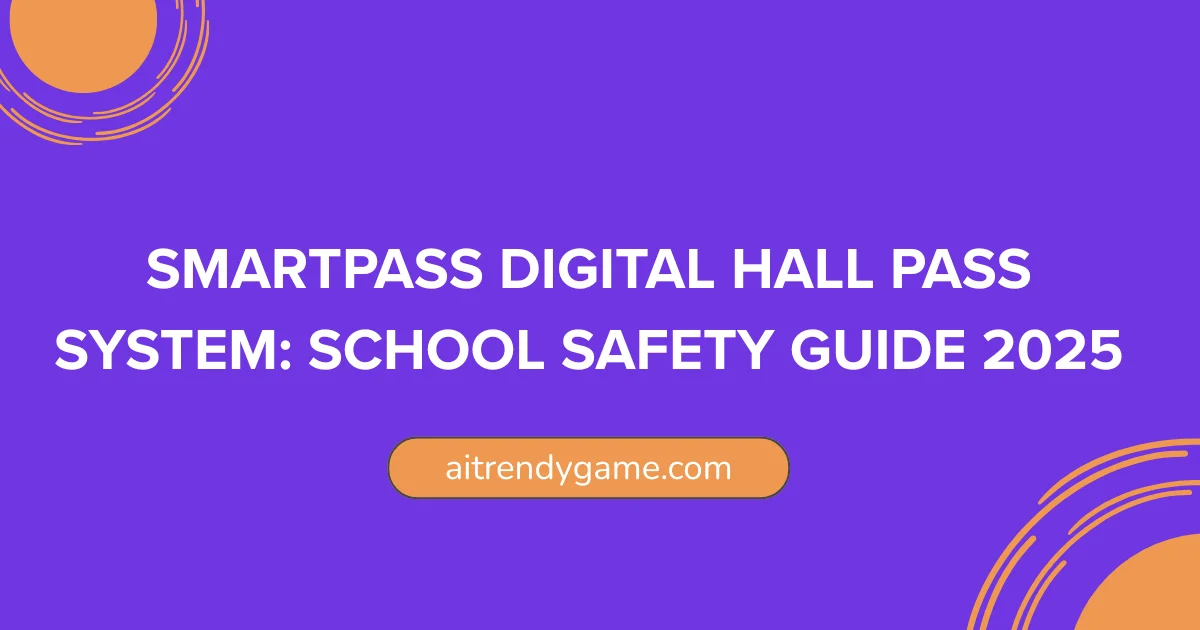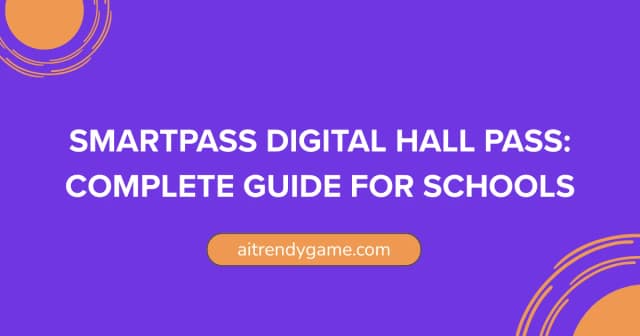
Managing student movement throughout school buildings has long challenged educators. Traditional hall passes—whether wooden blocks, paper slips, or lanyards—create disruptions, offer limited accountability, and provide no real-time visibility into student whereabouts. SmartPass emerged as a comprehensive solution that modernizes this essential aspect of school operations while prioritizing student safety and administrative efficiency.
What Is SmartPass?
SmartPass is a digital hall pass and student accountability platform designed specifically for K-12 schools. The system replaces outdated physical passes with a streamlined digital solution that works across web browsers and mobile devices. Students request passes electronically, teachers approve or deny requests with a few taps, and administrators gain real-time visibility into student movement patterns throughout their buildings.
The platform integrates seamlessly with existing school systems, including popular single sign-on solutions like Clever, making implementation straightforward for districts of any size. Schools ranging from small elementary buildings to large high school campuses have adopted SmartPass to create safer, more organized learning environments. Similar to how TeacherEase revolutionized standards-based grading and assessment, SmartPass brings digital transformation to student movement management.
Core Features That Address Real School Challenges
Digital Pass Request and Approval Process
Students initiate pass requests through the SmartPass interface in just three clicks. They select their destination—whether the restroom, nurse’s office, guidance counselor, or another location—and submit the request to their current teacher. Teachers receive instant notifications and can approve or deny requests based on classroom needs, hallway capacity, or other factors.
This digital workflow eliminates the interruptions that physical passes create. Teachers no longer need to stop instruction to hand over a hall pass or update a sign-out sheet. The entire process happens quietly and efficiently, allowing educators to maintain focus on teaching.
Real-Time Student Location Tracking
One of SmartPass’s most valuable features for school safety is its real-time tracking capability. Once a pass is activated, the system monitors how long students are out of class and where they’re located within the building. This visibility proves invaluable during emergencies when administrators need to account for every student quickly.
The tracking feature also helps identify patterns that might indicate concerning behavior. If a student consistently takes extended bathroom breaks or frequently requests passes during specific class periods, counselors and administrators can intervene proactively to provide appropriate support.
Preventing Unauthorized Student Meetups
SmartPass includes intelligent algorithms that prevent students from meeting in hallways without supervision. When two students from different classrooms request passes to the same location at overlapping times, the system flags the potential meetup. Teachers can see this information before approving requests, giving them the power to prevent situations that might compromise student safety or lead to disciplinary issues.
This feature addresses a significant concern in modern schools while respecting student privacy and maintaining a positive school culture. Students learn that accountability doesn’t mean distrust—it means everyone working together to create a safe learning environment.
Comprehensive Data and Analytics
School administrators gain access to detailed reports showing pass usage patterns across the building. These analytics reveal insights such as peak hallway traffic times, which destinations receive the most requests, average time students spend out of class, and individual student pass histories.
Data-driven decision making transforms school operations. Administrators can adjust policies based on actual usage patterns rather than assumptions. They might discover that certain hallway restrictions are unnecessary or that additional supervision is needed during specific times. The analytics also support conversations with parents about student behavior, providing concrete evidence rather than relying on anecdotal observations. Just as Therap’s electronic health records help care facilities make informed decisions through comprehensive data tracking, SmartPass enables educational institutions to optimize operations through detailed analytics.
The SmartPass and Flex Integration
SmartPass offers Flex, an additional module that extends beyond basic hall pass management to optimize entire school schedules. Flex helps schools implement flexible scheduling models where students choose how to spend designated periods—whether attending tutoring sessions, visiting the library, participating in clubs, or working independently.
The integration between SmartPass’s movement tracking and Flex’s scheduling capabilities creates a complete student management ecosystem. Schools using both tools report significant improvements in student engagement, academic support effectiveness, and overall building organization.
Benefits for Different School Stakeholders
For Teachers and Staff
Teachers regain instructional time previously lost to pass management logistics. The mobile apps for iOS and Android allow staff to manage passes from anywhere—during class, from the hallway, or while supervising other activities. Push notifications ensure they never miss urgent requests, and the ability to view student pass history helps inform classroom management decisions.
Staff members also appreciate the reduction in disputes about pass usage. The digital system creates an indisputable record, eliminating “he said, she said” situations that previously consumed administrative time. This streamlined approach to educational technology mirrors the efficiency that educational gaming platforms bring to engaging students in learning environments.
For Administrators
School leaders gain unprecedented visibility into building operations without needing to patrol hallways constantly. The system provides accountability data that supports positive behavior interventions, helps optimize supervision schedules, and demonstrates to school boards and parents that the district takes safety seriously.
During emergencies or lockdown situations, SmartPass becomes an invaluable tool for student accounting. Administrators can instantly see which students are outside classrooms, where they’re located, and ensure everyone reaches safety quickly.
For Students
Students benefit from a more predictable, fair system for requesting passes. They understand the expectations clearly, appreciate the reduced classroom disruptions, and often prefer the privacy of submitting digital requests rather than raising their hands in front of classmates to ask for bathroom breaks.
The system also teaches digital citizenship and responsibility. Students learn that their actions have records and consequences, preparing them for workplace environments where accountability and transparency are valued. This digital literacy development aligns with modern educational approaches that incorporate technology-enhanced learning experiences into everyday school activities.
For Parents and Guardians
Parents gain peace of mind knowing their children attend schools with robust safety measures. When concerns arise about student behavior or whereabouts during the school day, administrators can share specific data from SmartPass rather than vague recollections. This transparency builds trust between schools and families.
Implementation and Technical Considerations
Getting Started with SmartPass
Schools typically implement SmartPass in phases, starting with a pilot group of teachers before rolling out building-wide. The platform integrates with student information systems and single sign-on providers, minimizing technical barriers. Most schools complete full implementation within weeks rather than months.
The company provides comprehensive training resources including video tutorials, live webinars, and dedicated support staff. Teachers who initially feel hesitant about digital tools usually become enthusiastic advocates once they experience how SmartPass simplifies their daily routines.
Device Flexibility
SmartPass works on virtually any device with internet access. Schools don’t need to purchase specialized hardware—existing Chromebooks, iPads, smartphones, and desktop computers all support the platform. The responsive design ensures consistent experiences across different screen sizes and operating systems.
For schools concerned about device availability, SmartPass offers strategies such as dedicated hall pass stations at classroom doors or shared devices that students can use briefly to request passes. The flexibility mirrors how handheld gaming devices like the Lenovo Legion Go offer versatile computing experiences across different use cases.
Privacy and Security
SmartPass takes student data privacy seriously, complying with regulations including FERPA and state-specific privacy laws. The platform uses encryption to protect sensitive information and limits data access to authorized school personnel. Parents can request to review what information the system collects about their children.
The company regularly undergoes security audits and updates its infrastructure to protect against evolving cybersecurity threats. Schools receive transparent communication about data handling practices, helping them meet their obligations to protect student information.
Real-World Impact on School Safety
Emergency Response Capabilities
During fire drills, lockdowns, or other emergency situations, SmartPass transforms from a convenience tool into a critical safety resource. Teachers can instantly see which students from their classes are out of the building or in other locations. Office staff can generate complete reports showing every student’s location when the emergency began.
This capability dramatically reduces the time needed for accurate headcounts and helps first responders understand the situation quickly. In actual emergency situations, minutes matter—SmartPass helps schools account for every student in seconds rather than minutes.
Reducing Unsupervised Incidents
Before implementing SmartPass, many schools struggled with students wandering hallways, meeting up in unsupervised areas, or extending passes far beyond necessary. The system’s monitoring capabilities and intelligent blocking features significantly reduce these incidents without requiring additional staff or intrusive measures.
Schools report fewer disciplinary issues related to hallway behavior, decreased vandalism in restrooms and common areas, and improved overall building climate. When students know their movement is tracked, most choose to follow expectations—not from fear, but from understanding that the system exists to keep everyone safe.
Supporting Students in Crisis
For students experiencing mental health challenges, medical issues, or personal crises, SmartPass data helps school counselors and support staff notice patterns that warrant intervention. A student making frequent trips to the nurse, avoiding certain periods, or spending excessive time away from class might need additional support that staff can provide once they recognize the pattern.
This early warning capability makes SmartPass more than a management tool—it becomes part of a comprehensive student wellness strategy. Schools using the platform report catching concerning behaviors earlier and connecting students with appropriate resources more quickly than before.
Comparing SmartPass to Traditional Hall Pass Systems
Physical Pass Problems
Traditional wooden hall passes, lanyards, and clipboards create numerous challenges. They get lost, broken, or become unsanitary—especially concerning during flu season or pandemic situations. They provide no data for analysis, no way to prevent students from meeting inappropriately, and no mechanism for emergency accountability.
Physical systems also depend entirely on student honesty. A student could take a pass, hand it to a friend outside the classroom, or simply claim they returned it when they didn’t. These gaps in accountability create enforcement challenges and erode the effectiveness of the entire system.
Paper Sign-Out Sheet Limitations
Many schools attempted to add accountability to physical passes by implementing sign-out sheets where students record their departure and return times. While better than nothing, these sheets have significant flaws.
Students can easily fabricate times, sheets get lost or damaged, and analyzing the data requires someone manually reviewing pages of handwritten information. Teachers spend time enforcing sign-out compliance rather than teaching, and the sheets provide no real-time visibility for administrators trying to monitor building conditions.
Why Digital Solutions Win
SmartPass addresses every limitation of traditional systems while adding capabilities that physical passes could never provide. The automatic timing, real-time visibility, data analytics, and emergency response features create value that extends far beyond simply knowing which students are out of classrooms.
Schools that transition from physical to digital passes report they would never go back. The efficiency gains, safety improvements, and reduction in administrative headaches make SmartPass an investment that pays for itself through better outcomes and freed-up staff time.
Addressing Common Concerns About Digital Hall Passes
“Students Will Game the System”
Some educators initially worry that tech-savvy students will find ways to manipulate SmartPass. In practice, the system’s design makes this extremely difficult. The server-side timing, teacher approval requirements, and administrative oversight create multiple checks that prevent gaming attempts.
More importantly, schools report that when pass systems are fair, transparent, and consistently enforced, most students don’t try to circumvent them. SmartPass removes the inconsistencies that frustrated students about previous systems, reducing motivation to find workarounds.
“This Takes Away Student Independence”
Critics sometimes argue that monitoring student movement too closely prevents them from developing self-management skills. Schools using SmartPass counter that the system actually teaches responsibility better than unsupervised freedom.
Students learn to plan ahead, respect teacher discretion, manage their time effectively, and understand that freedom comes with accountability. These are precisely the skills they’ll need as adults in workplaces that track time, require explanations for absences, and expect employees to manage responsibilities independently within clear guidelines.
“We Don’t Have Enough Devices”
Device availability concerns often arise during implementation discussions. However, schools successfully using SmartPass have found creative solutions even with limited technology. Some strategies include classroom pass stations, teacher-managed devices, or allowing students to briefly borrow a classmate’s device for the few seconds needed to request a pass.
Additionally, as schools continue expanding one-to-one device initiatives, device scarcity becomes less of an issue over time. SmartPass works with whatever technology infrastructure a school currently has while adapting as that infrastructure improves.
Best Practices for Maximizing SmartPass Effectiveness
Establish Clear Policies Before Launch
Successful implementations begin with clearly defined expectations. Schools should develop written policies covering when students can request passes, how many passes are reasonable per period or per day, consequences for misuse, and emergency procedures.
Communicating these policies to students, parents, and staff before launch ensures everyone understands how SmartPass works and what behaviors are expected. The policies should align with existing school rules while taking advantage of SmartPass’s unique capabilities.
Train Staff Thoroughly
Even user-friendly technology requires proper training. Schools should provide multiple opportunities for staff to learn SmartPass features, practice with the interface, and ask questions before students begin using the system.
Creating teacher champions—enthusiastic early adopters who help their colleagues—accelerates adoption and provides peer support. These champions can troubleshoot common issues, share tips, and encourage hesitant staff members who might feel overwhelmed by new technology. This approach to professional development mirrors successful strategies used when implementing other educational technology platforms in classroom settings.
Start with a Pilot Group
Rather than implementing SmartPass building-wide immediately, many schools find success starting with volunteer teachers who are comfortable with technology. This approach allows working through unexpected issues with a smaller group, refining procedures based on real experience, and creating success stories that motivate other staff.
Pilot groups also generate student ambassadors who explain the system to their peers, making eventual full rollout smoother. Students who’ve used SmartPass often become its biggest advocates, encouraging friends to embrace rather than resist the change.
Review Data Regularly
SmartPass generates valuable data that should inform ongoing policy adjustments. Administrators should schedule regular reviews of pass patterns, identifying trends that suggest needed changes in policies, supervision, or support services.
For example, if data shows students requesting passes most frequently during first period, the school might consider allowing brief water breaks at the start of the day to reduce disruptions. If certain students show concerning patterns, counselors can proactively reach out before small issues become bigger problems.
Integrate with Positive Behavior Initiatives
SmartPass works most effectively when integrated with positive behavior support systems rather than used purely as a punitive tool. Schools might recognize students who use passes responsibly, create incentives for efficient hallway movement, or incorporate pass data into broader conversations about school culture.
This positive framing helps students see SmartPass as a tool that supports their needs rather than something imposed to control them. When students feel the system serves them, they become partners in making it work effectively. Similar gamification strategies have proven successful in educational gaming environments where positive reinforcement drives engagement.
The Future of Student Management Technology
SmartPass represents the current state of digital student management, but the field continues evolving. Future developments may include integration with building access control systems, artificial intelligence that predicts potential safety issues before they occur, or connections with mental health screening tools that help identify students needing support.
As schools increasingly rely on data to inform decisions, platforms like SmartPass that provide accurate, actionable information will become even more essential. The question isn’t whether schools will adopt digital student management tools, but how quickly they’ll transition from outdated systems that fail to meet modern safety and accountability needs.
Making the Decision: Is SmartPass Right for Your School?
Schools considering SmartPass should evaluate their current challenges with student movement management, their readiness for digital transformation, and their priorities around student safety and accountability. Districts struggling with outdated pass systems, lacking visibility into building operations, or seeking better emergency response capabilities often find SmartPass addresses their exact needs.
The investment includes not just financial costs but also time for training and adjustment. However, schools consistently report that benefits appear quickly—often within the first weeks of implementation as teachers experience reduced disruptions and administrators gain insight into building operations they never had before.
Ultimately, SmartPass succeeds because it solves real problems that every school faces. Student movement is an inevitable part of school operations, and managing it effectively impacts everything from instructional time to emergency safety. By bringing this aspect of school management into the digital age, SmartPass helps educators focus on what matters most: teaching and supporting students in safe, organized learning environments.
For schools looking to explore other digital solutions that enhance educational operations, platforms like ShortStack for contest management demonstrate how technology can streamline administrative tasks while improving engagement and outcomes.
Schools interested in exploring SmartPass can request demonstrations to see the platform in action, review case studies from similar institutions, and discuss implementation timelines that work for their unique situations. The transition to digital hall passes represents a meaningful step toward creating safer, more efficient schools where technology serves the mission of excellent education for every student.
Found this helpful? Share it with others who might benefit!
The Premier AI Gaming Directory for Global Visibility
AITrendyGame connects game developers with 100K+ monthly users. Submit your game for instant global exposure, premium backlinks & social promotion.
Submit Your Game 🚀Related Articles

TeacherEase Guide: Standards-Based Learning Platform Review
TeacherEase is a cloud-based student information system designed specifically for K-12 schools implementing standards-based learning and differentiated instruction. Unlike traditional grade-book systems that focus solely on letter grades, this platform helps educators track student mastery of specific learning standards throughout the academic year. As someone who has analyzed education technology platforms for over eight years, […]

Therap: Leading Electronic Health Records for Service Providers
The healthcare documentation landscape has evolved dramatically over the past decade, and service providers working with individuals who have developmental disabilities need robust systems that go beyond basic record-keeping. This is where Therap has established itself as the industry leader, transforming how organizations document care, track outcomes, and ensure compliance. What is Therap? Therap Services […]

ShortStack Review 2025: Create Contests & Grow Your Email List
If you’ve been searching for ways to grow your email list, boost social media engagement, or generate leads without burning through your marketing budget, you’ve probably come across ShortStack. But does this contest and sweepstakes platform actually deliver results—or is it just another overhyped marketing tool? I’ve spent considerable time testing ShortStack’s features, analyzing user […]

SmartPass Digital Hall Pass: Complete Guide for Schools 2025
SmartPass is a digital hall pass system transforming how schools manage student movement, reducing hallway incidents by up to 64% while providing real-time accountability data. However, successful implementation requires careful planning around student concerns, technical infrastructure, and clear policies. The traditional paper hall pass system—with its lanyards, clipboards, and sign-out sheets—has been a staple of […]
Ready to Join theGaming Revolution?
The future of game discovery starts here. Connect your creation with passionate players worldwide through AITrendyGame – where talented developers meet eager gamers, and great games find their perfect audience.
Your Game Here
Reach millions of players